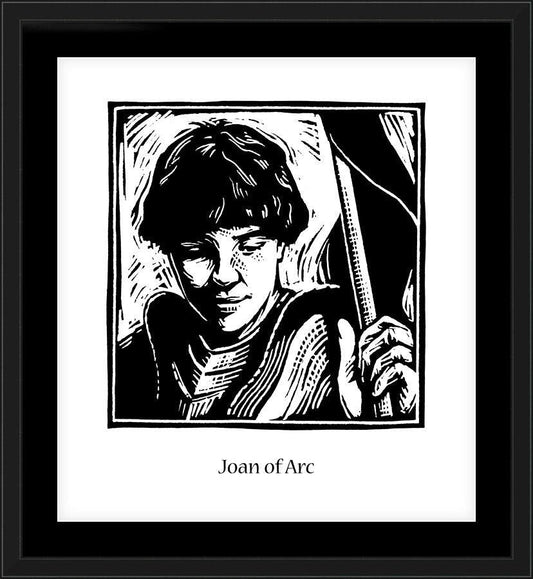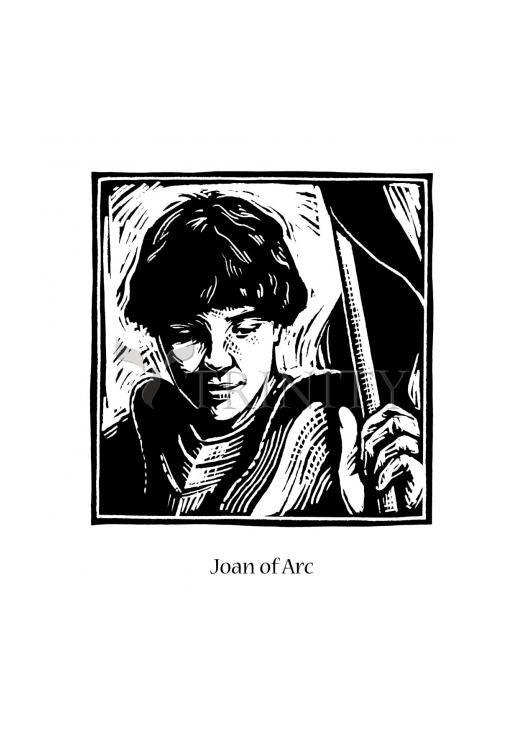Joan of Arc ("Jeanne d'Arc" in modern French; "Jehanne Darc" in medieval French) was born circa 6 January 1412 in the village of Domremy, France, during the series of conflicts which we now call the Hundred Years War.
The English launched a new invasion in 1415 at a time when the French were divided into hostile "Armagnac" and "Burgundian" factions, a situation which would be an important factor during Joan of Arc's campaigns and trial. The Armagnacs were originally led by the Duke of Orleans and Count of Armagnac before becoming linked with the uncrowned Dauphin (claimant to the throne), who would be anointed as Charles VII with Joan of Arc's help. The Burgundians were supporters of the Duke of Burgundy, who allied himself with the English in 1420. Joan would be captured by pro-Burgundian troops and put on trial by pro-English and Burgundian clergy.
Joan said that around the summer of 1424 she began receiving visions of the Archangel Michael, St Catherine [of Alexandria], St. Margaret [of Antioch], and occasionally others such as the Archangel Gabriel. She said these visions ordered her to lift the siege of Orleans on behalf of its captive Duke and to bring the Dauphin to Rheims for his coronation.
Military Campaigns
In February 1429 she convinced Lord Robert de Baudricourt to provide an escort of soldiers to bring her to the Royal Court at Chinon. After an eleven-day journey through enemy-held territory, she was allowed to present her case to the Dauphin Charles. He was encouraged by her words but sent her to the city of Poitiers to be examined by a group of high-ranking clergy, including the Archbishop of Rheims, the Inquisitor of Toulouse, several Bishops, and a number of prominent theologians. They told Charles that "nothing improper has been found in her, only good, humility, chastity, piety, propriety, simplicity."
This approval prompted Charles to allow her to accompany an army to Orleans. She arrived on April 29th. Her troops took the English fortress built around the Church of St. Loup on May 4th, followed by the fortress of the Augustinians on May 6th, followed by Les Tourelles on the 7th. The English cancelled the siege the next day. This victory was followed by the capture of Jargeau on June 12th, the bridge at Meung-sur-Loire on the 15th, and the town of Beaugency on the 17th. The next day witnessed a larger victory when the English lost over half their field army near Patay on June 18th.
These events opened the way for a campaign designed to bring Charles VII to Rheims, the traditional site of Royal coronations. After accepting the surrender of the city of Troyes and other towns along the way, the army entered Rheims on July 16th. The coronation took place the following day.
At this point the Royal government negotiated a fifteen-day truce with the Duke of Burgundy, followed by a four-month truce concluded on August 21st which served little purpose other than to prevent the Royal army from seizing additional locations at this crucial time.
The army did attempt an unsuccessful attack against English-held Paris on September 8th, during which Joan was wounded by a crossbow arrow. Charles decided to abandon the campaign immediately afterward and ordered the troops to return to the Loire Valley. The army was disbanded on September 21st.
Joan of Arc took part in a brief campaign that autumn during which Royal troops captured the town of St-Pierre-le-Moutier on November 4 and then unsuccessfully tried to besiege La-Charite-sur-Loire in late November and early December.
During the winter she resided at various Royal estates, then returned to the field the following spring. She received little direct support from the Royal government, which was still hoping to establish a permanent peace. This may be the context for a letter she dictated to a scribe on 23 March 1430, in which she threatens to lead a crusading army against the Hussites unless they "return to the Catholic Faith and the original Light".
At Lagny-sur-Marne in April 1430, Joan accompanied an army which defeated a small force led by a pro-English mercenary named Franquet d'Arras.
She was then spurred to more desperate action when the Duke of Burgundy launched a campaign against the city of Compiegne, which had refused to place itself under his jurisdiction as required by the terms of the treaty established the previous August. Joan was present when a small Armagnac force tried to capture the bridge at Pont-l'Eveque c. May 16th in order to sever Burgundy's line of supply. This attack failed.
As the Burgundian army laid siege to Compiegne itself, Joan made a fateful decision to go to the city's aid despite having predicted that she would be captured "before St. John's Day" (June 24th).
She brought a small number of troops into Compiegne on the morning of May 23rd. Later that day she was present during an attack against the Burgundian camp at Margny north of the besieged city. Burgundian troops which were concealed behind the Mont-de-Clairoix hill suddenly emerged and forced her soldiers to retreat, then surrounded her small group when the nearest drawbridge leading into Compiegne was shut, thereby blocking her only route of escape. She refused to surrender until a Burgundian archer rode up behind her and pulled her off her horse. Lionel of Wandomme, a member of John of Luxembourg's contingent, pushed his way through the crowd and convinced her to surrender to him.
This action initiated the sequence of events which allowed the English to obtain her and place her on trial.
Born: January 6, 1412 at Greux-Domremy, Lorraine, France
Died: Burned alive on May 30, 1431 at Rouen, France
Beatified: April 11, 1905 by Pope Saint Pius X
Canonized: May 16, 1920 by Pope Benedict XV
Name Meaning: God is gracious
Also known as: Maid of Orleans; Jeanne d'Arc; Jean D'arc; Jehanne Darc




















